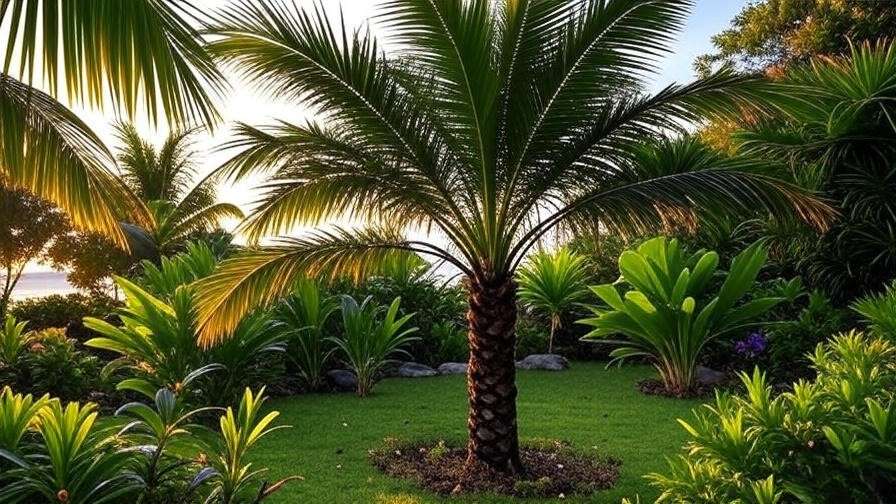Imagine a lush, tropical oasis in your backyard, anchored by the striking elegance of a black palm tree, its dark, glossy trunk rising gracefully beneath a canopy of vibrant, feathery fronds. This exotic beauty, often revered for its unique aesthetic, can transform any garden or indoor space into a tropical paradise. Whether you’re a seasoned plant enthusiast or a beginner eager to cultivate a black palm tree, this comprehensive guide will equip you with expert-backed strategies to ensure your palm thrives. From planting to pest control, we’ll cover everything you need to know to nurture this stunning tropical plant successfully. 🌞
In this article, we’ll dive deep into the world of black palm tree care, addressing common challenges and offering practical solutions to help your palm flourish. Backed by horticultural expertise and insights from tropical plant studies, this guide is designed to be your go-to resource for growing a healthy, vibrant black palm. Let’s embark on this journey to create a thriving tropical masterpiece! 🌴
1. What is a Black Palm Tree? 🖤
1.1 Overview of the Black Palm Tree
The black palm tree, often exemplified by species like Astrocaryum standleyanum, is a stunning tropical plant native to Central and South America. Known for its dark, almost ebony-colored trunk and lush, feather-like fronds, this palm stands out in any landscape. Its unique appearance makes it a favorite among gardeners and landscapers aiming to add a touch of the tropics to their spaces. Black palms typically grow in humid, forested regions, thriving in warm climates with ample rainfall. Culturally, these trees have been used in indigenous communities for their durable wood and edible fruits, adding to their allure.
Beyond aesthetics, black palm trees are prized for their adaptability to both outdoor gardens and indoor environments, provided their care needs are met. Their slow-to-moderate growth rate makes them manageable for home growers, while their striking look elevates any setting. According to the Missouri Botanical Garden, black palms are hardy in USDA zones 10-11, making them ideal for tropical and subtropical regions.
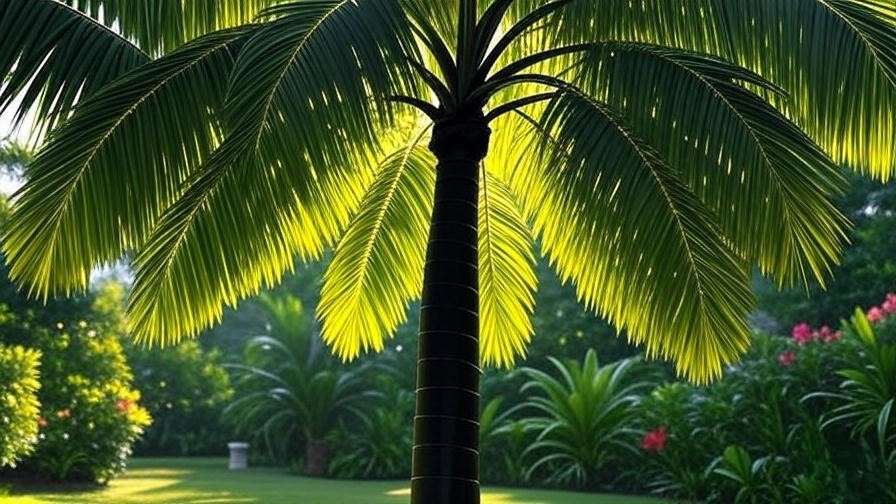
1.2 Types and Varieties
Several black palm species are suitable for cultivation, each with distinct characteristics. The Astrocaryum standleyanum is a popular choice, growing up to 20-30 feet tall with a slender, dark trunk. Another variety, Astrocaryum mexicanum, is smaller, making it ideal for container gardening or indoor spaces. Differences in frond shape, trunk texture, and growth habits allow gardeners to choose a variety that fits their space and aesthetic preferences. For instance, Astrocaryum alatum features slightly broader fronds, adding a fuller look to landscapes.
When selecting a black palm, consider your climate and space constraints. Smaller varieties are perfect for patios or indoor corners, while larger species suit expansive gardens. Expert Insight: A 2019 study from the University of Florida’s Tropical Research Center highlights the adaptability of Astrocaryum species to varying light conditions, making them versatile for diverse growing environments.
2. Why Choose a Black Palm Tree for Your Garden? 🌞
2.1 Aesthetic and Functional Benefits
A black palm tree is more than just a plant—it’s a statement. Its dark trunk and vibrant green fronds create a dramatic contrast, making it a focal point in any garden or indoor space. Whether used as a standalone feature or paired with other tropical plants like bird of paradise or hibiscus, the black palm adds sophistication and exotic charm. Functionally, it provides shade in outdoor settings, creating cool, inviting areas for relaxation. For indoor growers, its compact varieties fit beautifully in living rooms or sunlit corners, enhancing decor with minimal effort.
Black palms are also relatively low-maintenance compared to other tropical plants, requiring consistent but straightforward care. Their slow growth means less frequent repotting or pruning, making them ideal for busy plant enthusiasts.
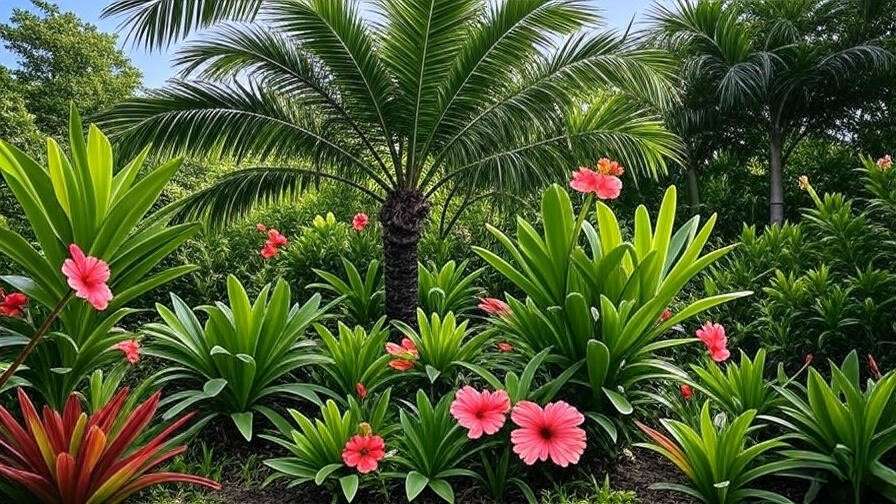
2.2 Environmental and Ecological Value
Black palm trees contribute to biodiversity by supporting local ecosystems. In their native habitats, they provide food and shelter for birds and insects, and their deep roots help prevent soil erosion. In home gardens, they can improve air quality and create microclimates that benefit nearby plants. Their adaptability to warm, humid climates makes them a sustainable choice for tropical regions, where they thrive without excessive water or chemical inputs.
Tip: Compared to other palms like coconut or date palms, black palms require less space and are less prone to toppling in high winds, making them a practical choice for coastal or windy areas.
3. Essential Growing Conditions for Black Palm Trees 🌡️
3.1 Light Requirements
Black palm trees thrive in bright, indirect light or partial shade, mimicking their natural understory habitat. Outdoors, place them where they receive filtered sunlight or morning sun with afternoon shade to prevent leaf scorching. Indoors, position them near east- or west-facing windows for optimal light exposure. If natural light is limited, supplement with full-spectrum grow lights, providing 12-14 hours of light daily. According to horticultural studies from the Royal Botanic Gardens, Kew, consistent light exposure promotes healthy frond development and vibrant coloration.
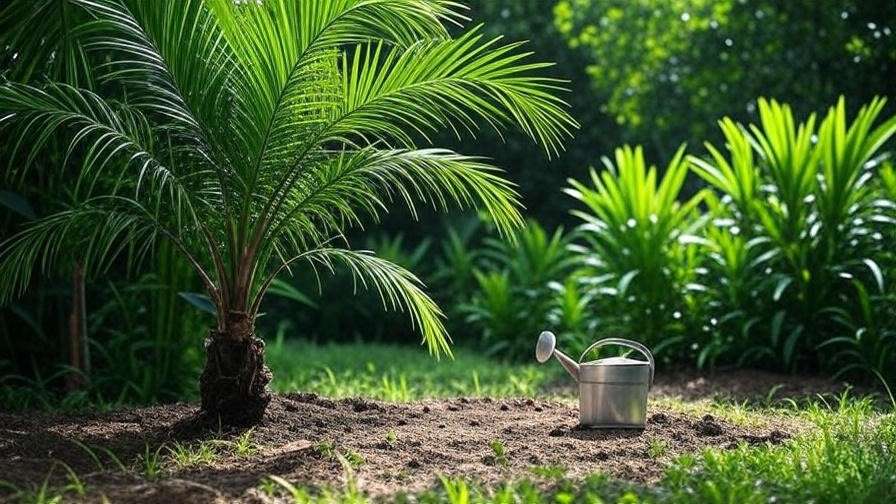
3.2 Soil Preferences
Well-draining, nutrient-rich soil is critical for black palm trees. A mix of potting soil, sand, and perlite in a 2:1:1 ratio works well, ensuring proper drainage while retaining moisture. Aim for a soil pH of 6.0-7.0, slightly acidic to neutral. Adding organic compost or peat moss boosts nutrient content, supporting robust growth. For container-grown palms, ensure pots have drainage holes to prevent waterlogging, which can lead to root rot.
3.3 Temperature and Humidity
Black palms thrive in temperatures between 70-90°F (21-32°C), with high humidity levels of 60-80%. They tolerate brief dips to 50°F (10°C) but should be protected from frost. Indoors, maintain humidity with a humidifier, pebble trays, or regular misting, especially in dry climates or during winter heating. Outdoor palms benefit from natural humidity in tropical regions but may need occasional misting in drier areas.
3.4 Watering Needs
Water black palm trees when the top inch of soil feels dry, typically every 7-10 days for outdoor plants and 10-14 days for indoor ones. Use lukewarm water to avoid shocking the roots, and ensure excess water drains completely. In summer, increase watering frequency to support active growth, but reduce it in winter to prevent overwatering. Overwatering is a common cause of root rot, so always check soil moisture before watering.
Expert Insight: A 2021 study from the International Palm Society emphasizes consistent moisture without saturation for optimal palm health, particularly for Astrocaryum species.
4. Step-by-Step Guide to Planting a Black Palm Tree 🌱
4.1 Choosing the Right Location
Selecting the perfect spot is crucial for your black palm’s success. Outdoors, choose a location with partial shade, protected from strong winds that could damage fronds. Ensure the area allows for root expansion, as black palms develop deep root systems. Indoors, opt for a bright corner with indirect light, away from drafts or heating vents. Consider the mature size of your chosen variety—larger species need more space, while smaller ones suit patios or apartments.
4.2 Planting Process
- From Seeds: Soak black palm seeds in warm water for 24-48 hours to soften the outer coat. Plant in a seed-starting mix, 1 inch deep, and keep at 80-85°F (27-29°C) with high humidity. Germination may take 2-3 months.
- From Seedlings: Choose healthy seedlings with vibrant fronds. Dig a hole twice the width of the root ball and as deep as the container. Place the seedling, backfill with soil, and water thoroughly.
- Mature Plants: For transplants, ensure the root ball remains intact. Plant at the same depth as the original container, and stake if needed to stabilize.
Water thoroughly after planting and mulch around the base to retain moisture.
4.3 Container vs. Ground Planting
Container planting suits indoor or small-space growers, offering mobility and control over soil conditions. Use a pot at least 12-16 inches in diameter with drainage holes. Ground planting is ideal for landscapes, allowing natural root growth but requiring well-prepared soil. Containers need repotting every 2-3 years, while ground-planted palms require less frequent intervention.
Example: A Florida homeowner successfully grew an Astrocaryum mexicanum in a large terracotta pot, moving it indoors during rare cold snaps, resulting in a thriving 6-foot palm within three years.
5. Caring for Your Black Palm Tree: Maintenance Tips 🧑🌾
5.1 Pruning and Cleaning
Regular pruning keeps your black palm tree looking tidy and promotes healthy growth. Remove dead, yellowing, or damaged fronds using sharp, sterilized pruning shears to prevent disease spread. Cut close to the trunk, but avoid damaging the bark. For larger outdoor palms, use a pole pruner for safety. Clean the trunk periodically with a damp cloth to remove dust or debris, especially for indoor plants. Avoid over-pruning, as black palms rely on their fronds for photosynthesis. Prune sparingly, typically once or twice a year, during spring or early summer for optimal recovery.
Safety Tip: Wear gloves and protective eyewear when pruning to avoid injury from sharp frond edges. According to the American Horticultural Society, proper pruning enhances palm vigor and reduces pest habitats.
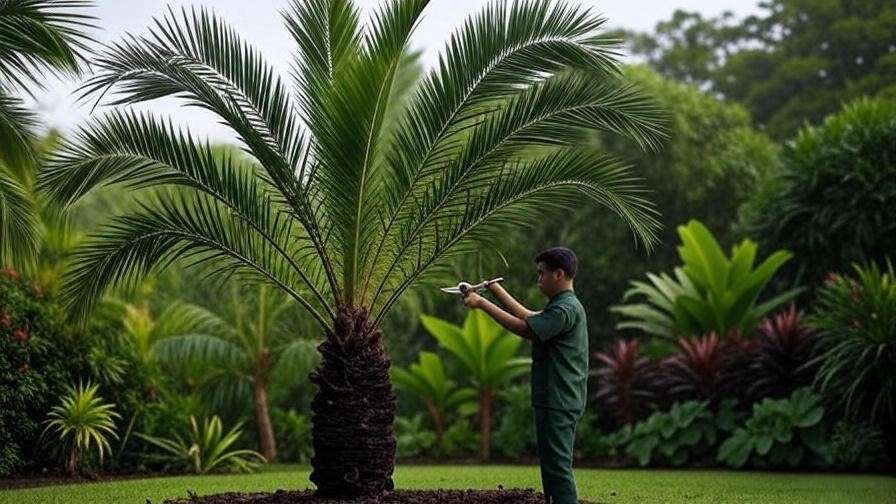
5.2 Fertilizing
Black palm trees benefit from a balanced, slow-release fertilizer formulated for palms, such as a 8-2-12 or 10-10-10 NPK ratio. Apply fertilizer every 2-3 months during the growing season (spring and summer) to support lush frond growth and strong roots. Use granular fertilizers for ground-planted palms and liquid fertilizers for potted ones, following package instructions to avoid over-fertilization, which can cause nutrient burn or salt buildup. In fall and winter, reduce or stop fertilizing to align with the palm’s dormant phase.
Pro Tip: Incorporate a micronutrient supplement containing magnesium and potassium to prevent deficiencies, which can lead to yellowing fronds. A 2020 study from the University of Hawaii’s Tropical Plant and Soil Sciences Department recommends palm-specific fertilizers for optimal Astrocaryum health.
5.3 Pest and Disease Management
Common pests affecting black palm trees include spider mites, scale insects, and mealybugs, which can cause frond discoloration or stunted growth. Inspect fronds regularly, especially undersides, for signs of infestation. Treat minor pest issues with neem oil or insecticidal soap, applied early in the morning for best results. For severe infestations, consult a local extension service for targeted chemical treatments, but prioritize eco-friendly options to protect beneficial insects.
Fungal infections, such as root rot or leaf spot, can occur in overly wet conditions. Ensure proper drainage and avoid overhead watering to prevent fungal growth. If leaf spot appears, remove affected fronds and apply a copper-based fungicide. Expert Insight: The International Society for Horticultural Science notes that maintaining good air circulation around black palms significantly reduces disease risk.
Maintenance Checklist:
- Check fronds monthly for pests or discoloration.
- Clean tools after each use to prevent disease spread.
- Rotate indoor palms every few weeks for even light exposure.
6. Common Challenges and How to Overcome Them 🚫
6.1 Yellowing Fronds
Yellowing fronds are a common issue with black palm trees, often caused by nutrient deficiencies, overwatering, or insufficient light. To diagnose, check soil moisture—soggy soil suggests overwatering, while dry soil indicates under-watering. Test soil for nutrient levels; low potassium or magnesium can cause yellowing. Correct by adjusting watering habits and applying a palm-specific fertilizer with micronutrients. If light is the issue, relocate the palm to a brighter spot or supplement with grow lights. Regular monitoring prevents recurrence.
6.2 Slow Growth
Slow growth in black palm trees may result from inadequate light, poor soil quality, or low humidity. Ensure the palm receives 6-8 hours of indirect sunlight daily and maintain humidity above 60%. If soil is compacted or nutrient-poor, repot with a fresh, well-draining mix or amend ground soil with compost. For indoor palms, use a humidifier during dry seasons. Patience is key—black palms grow slowly, often adding just 6-12 inches per year under ideal conditions.
6.3 Indoor Growing Challenges
Indoor black palms face challenges like low humidity, limited light, and restricted root space. Combat low humidity with a pebble tray or humidifier, aiming for 60-80% humidity. Use grow lights if natural light is insufficient, and choose pots at least 2 inches larger than the root ball to allow growth. Rotate the plant every 2-3 weeks to ensure even light exposure. Expert Insight: A 2022 report from the Royal Horticultural Society emphasizes humidity as a critical factor for indoor tropical palm success.
7. Seasonal Care Tips for Black Palm Trees 🍂
7.1 Summer Care
Summer is the active growing season for black palm trees. Increase watering to keep soil consistently moist, but not waterlogged, checking every 5-7 days. Provide extra shade during intense heat to prevent frond scorching, especially for young palms. Apply fertilizer monthly to support vigorous growth. For indoor palms, ensure good air circulation to prevent fungal issues during humid summer months.
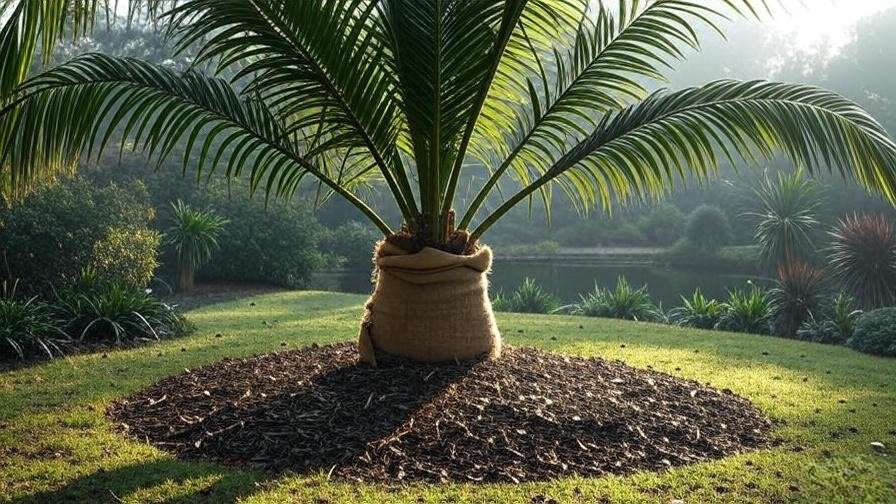
7.2 Winter Care
In winter, black palms enter a dormant phase, requiring less water and no fertilization. Water every 10-14 days, allowing soil to dry slightly between waterings. Protect outdoor palms from cold snaps by wrapping the trunk with burlap or moving potted palms indoors if temperatures drop below 50°F (10°C). For indoor palms, keep away from heating vents to avoid drying out fronds.
7.3 Year-Round Monitoring
Consistent care ensures long-term health. Check for pests, monitor soil moisture, and adjust light exposure as seasons change. Seasonal Care Calendar:
- Spring: Resume fertilizing, prune dead fronds.
- Summer: Increase watering, provide shade.
- Fall: Reduce watering, prepare for dormancy.
- Winter: Protect from cold, minimize care.
8. Black Palm Tree in Landscaping and Design 🎨
8.1 Incorporating into Garden Design
Black palm trees shine as focal points in tropical or modern landscapes. Plant them near water features or pathways for dramatic effect, pairing with colorful companions like bromeliads, calatheas, or ginger plants. Their dark trunks contrast beautifully with lighter foliage, creating visual depth. For small gardens, use dwarf varieties like Astrocaryum mexicanum in clusters to mimic a jungle aesthetic. Ensure adequate spacing (6-10 feet) to accommodate mature growth.
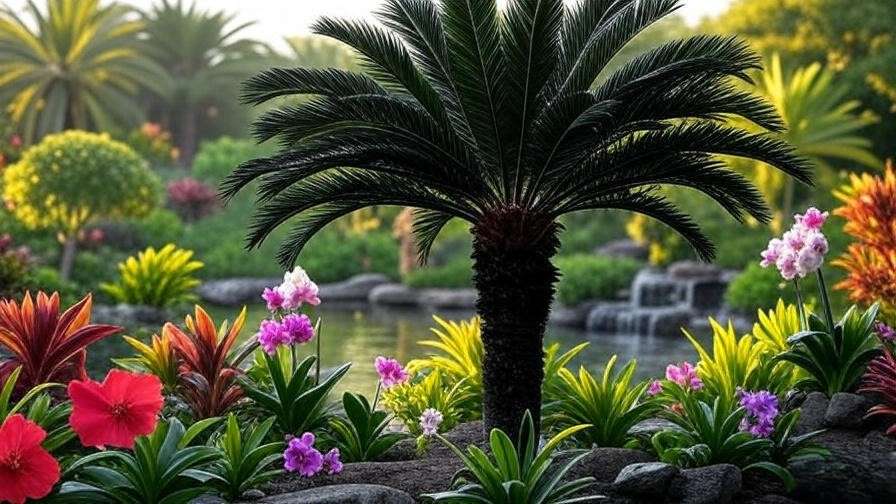
8.2 Indoor Styling Tips
Indoors, black palms elevate decor as statement pieces. Place in decorative ceramic pots with neutral tones to highlight the dark trunk. Position in bright corners of living rooms or offices, complementing with minimalist furniture for a modern look. Use saucers to catch drips and maintain cleanliness. Example: A California interior designer transformed a living space by placing a potted black palm near a floor-to-ceiling window, creating a tropical vibe with minimal effort.
9. FAQs About Black Palm Tree Care ❓
- How fast do black palm trees grow?
Black palms grow slowly, typically 6-12 inches per year under ideal conditions. Growth rates vary by species and care quality. - Can black palm trees survive indoors year-round?
Yes, with bright indirect light, high humidity, and proper care, black palms thrive indoors. Use grow lights and humidifiers in challenging environments. - What are the best fertilizers for black palm trees?
Use a slow-release 8-2-12 or 10-10-10 NPK fertilizer with micronutrients, applied every 2-3 months during the growing season. - How do I prevent pests on my black palm tree?
Inspect regularly, use neem oil for early infestations, and maintain good air circulation to deter pests. - Are black palm trees safe for pets?
Black palms are non-toxic to pets, but their sharp frond edges may pose a minor injury risk. Keep out of reach of curious pets.
10. Conclusion: Enjoy Your Thriving Black Palm Tree! 🌴
Growing a black palm tree is a rewarding journey, transforming your space into a tropical haven with its unique beauty and low-maintenance charm. By following this guide—covering light, soil, watering, and pest management—you’re equipped to nurture a healthy, vibrant palm. Whether you’re enhancing your garden or styling your home, the black palm tree offers endless possibilities. Start today, and share your success stories or questions in the comments below! Explore our other plant care guides for more tips to elevate your green oasis.
Call-to-Action: Ready to grow your own black palm? Visit our site for more tropical plant care resources, and share this guide with fellow plant lovers!

